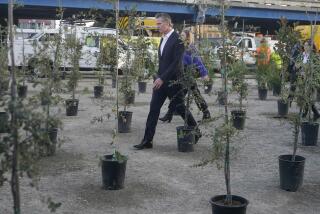Facing Up to Climate Shift
Few issues confronting policymakers seem harder to get a handle on than global warming. Many scientists definitely link hurricanes, floods, droughts and other natural disasters to climatic change. But many environmental activists base their predictions of dire calamity on speculative science and advocate politically unrealistic solutions.
Sacramento is not about to ban construction in Malibu, even though environmentalists say development will provide kindling for the fires that increasingly hot and dry winds will bring. Nor is Washington likely to eliminate popular agricultural subsidies even though their absence might encourage farmers to plant fewer water-intensive crops. What, then, is a realistic path?
In recent months climatologists have come to agree that global warming is a certainty and that government should take economical steps to prepare for it. The most recent evidence is a two-year study of climate change in California released Thursday by the Union of Concerned Scientists and the Ecological Society of America. The study concludes that over the next half-century temperatures in the state could rise as much as six degrees on average during the winter, leading to ecological changes like increased winter flooding and decreased summer stream flows.
Since even a small temperature rise would significantly alter the state’s ecology, studying adaptation makes sense. Natural resource experts like Peter H. Gleick, president of the Pacific Institute for Studies in Development, Environment and Security, a Berkeley think tank, point out that most state agencies haven’t even begun to think about the issue. Gleick suggests starting with Cal-Fed, the state/federal water-use planning group, and state water agencies. They should begin factoring global warming predictions into their computer modeling, Gleick says. These plans would help hydrologists decide, for instance, how much water to keep in California’s dam system to prevent flooding.
Similarly, land-use planners should begin assessing subsidies that encourage housing development in flood plains, like the current building boom along the Sacramento River. California’s land-use planning has been infamously shortsighted, but there are some sparks of change out there. Former Modesto Mayor Carol Whiteside, for instance, is expanding a think tank called the Great Valley Center that applies the kind of long-range planning to the Central Valley that the state Coastal Commission developed for the shoreline.
Meanwhile, ecologists at the state Department of Parks and Recreation are seeking ways to control invasive, nonnative plants like the yellow star thistle, which crowds out valuable native plants from new territory, preventing them from moving into cooler climate areas.
California’s historical failures to anticipate ecological problems have been expensive. To this day, for instance, the excessive recovery of underground water early in this century makes some agricultural lands too salty to plant. Ecologically and economically, planning for climate change makes sense.
More to Read
Sign up for Essential California
The most important California stories and recommendations in your inbox every morning.
You may occasionally receive promotional content from the Los Angeles Times.










